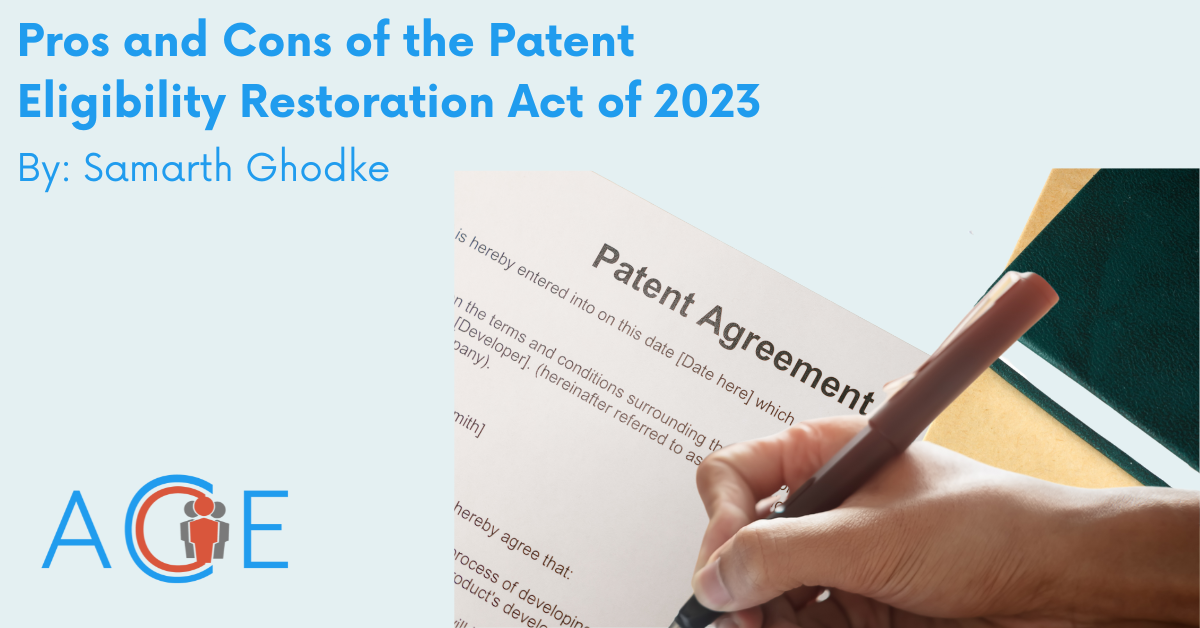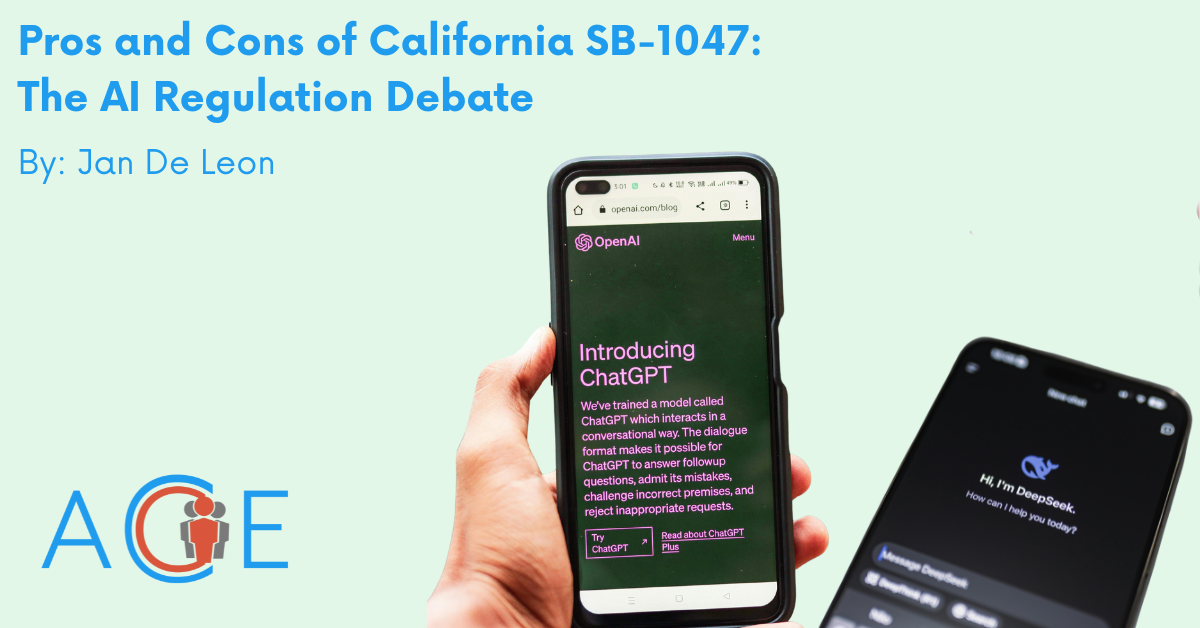Background Information
Artificial intelligence (AI) is transforming the patent landscape, creating an influx of patent applications that mirrors a rise in modern-day innovation. However, the discussion of patentable inventions under U.S. law lags behind. The Patent Eligibility Restoration Act of 2023 (PERA) aims to address this by reversing court rulings that have narrowed the scope of patent eligibility in emerging fields like AI. Ultimately, PERA stands at the intersection of technology, law, and political ideology, shaping the role of government in maintaining intellectual property (IP).
Supreme Court decisions in Mayo v. Prometheus and Alice v. CLS are widely recognized as turning points in patent law. The cases, which restricted patent eligibility for abstract ideas and natural laws, marked the first narrowing of patent eligibility since the 1950s. PERA would “eliminate all judicial exceptions” to patent law in an attempt to remedy the confusion caused by the Mayo and Alice rulings. The bill was introduced in the Senate by Senators Thom Tillis (R-NC) and Chris Coons (D-DE) in 2023. Its House companion was introduced by Representatives Scott Peters (D-CA) Kevin Kiley (R-CA) in 2024. While it received bipartisan support and a hearing in the Senate Intellectual Property Subcommittee, PERA ultimately died in committee at the end of the 118th Congress.
PERA presents three key advantages:
- Economic and Innovation Benefits: Boosts innovation and economic growth.
- International Competitiveness: Secures U.S. innovation against global competitors.
- Expansion of AI and other emerging technologies: Clarifies AI patent eligibility to strengthen U.S. leadership on the global stage.
In terms of economic and innovative benefits, the United States Patent and Trademark Office advocates for PERA as a catalyst for innovation. It specifically states that small to medium-sized firms “need clear intellectual property laws that incentivize innovation…[as it’s] critical for job creation, economic prosperity,” in addition to several extended impacts. Furthermore, the American Intellectual Property Law Association (AIPLA), argues that PERA enacts clearer policies that will generate efficient product development and innovation, improving both industry standards and marginal utility for the consumer. Wilson Sonsini, a nonpartisan outlet that conducts the legal analysis, finds that the bill would in fact reverse the stagnation of innovation. In a written testimony submitted to the Senate Subcommittee on Intellectual Property, law professor Adam Mossoff argued that PERA is essential for restoring American dominance in global innovation and patent sectors.
PERA not only aims to improve U.S. innovation and investment, but also clarifies AI patentability to bolster America’s edge on the global stage. According to Republican Representative Kevin Kiley, the U.S. must expand patentability to compete with China, emphasizing PERA as a key to gaining a competitive edge through clearer patent laws. In an interview with Representative Kiley, the Center for Strategic and International Studies (CSIS) found that China’s approach to intellectual property poses a significant threat to American innovation and prosperity, strengthening the case for PERA. Senator Coons, a PERA co-sponsor, believes that the bill is necessary to help the U.S. catch up to Europe and China in the realm of AI patent law.
Other supporters argue that PERA’s expansion of patentability will open the door to advancement in domestic AI technology. A multinational law firm argues that expanding patent eligibility to AI models and business methods is crucial for the development of the U.S. technology industry. By broadening patentability, PERA can reduce the backlog of unsuccessful patents, sparing inventors from having to revalidate their claims. To reinforce this, the global law firm McDermott Will & Emery contends that PERA reduces ambiguity in patent eligibility by defining AI-related patents and human involvement in AI inventions.
However, while PERA offers significant benefits for innovation, global competitiveness, and emerging technologies, it also raises concerns about potential drawbacks, including the risk of overly broad patents and unintended legal complexities.
PERA presents three key disadvantages:
- Overbroad Patentability: Risks limiting access to life-saving technologies.
- Hurting Small Inventors: Creates an ambiguous legal landscape that only large corporations can afford to navigate.
- Ethical and Global Concerns: Conflicts with global patent norms, risking international relations.
The NYU Journal of Intellectual Property and Entertainment Law highlights concerns that broadening patent eligibility could negatively impact the life sciences sector by creating barriers between consumers and newly-patented technologies. It argues that PERA undermines the balance between rewards gained from innovation and public accessibility to products they depend on. Another critique from the Center for Innovation Promotion finds that PERA disrupts established legal standards, creating uncertainty in the patent system. Its broad eligibility could stifle innovation by exacerbating patent disruptions instead of encouraging progress and innovation.
Other critics worry that PERA could negatively impact small businesses. U.S. Inventor, an inventor’s rights advocacy group, critiques the bill for creating a complex legal landscape that only large corporations can afford to navigate. It argues that PERA lacks definitions for most of its crucial terms will only create more confusion, stating, “Investment into anything that risks falling into PERA’s undefined ineligibility exclusions will be hobbled.”
PERA also raises ethical concerns, particularly in its treatment of genetic material, which may conflict with international patent standards. According to the NYU Journal of Intellectual Property and Entertainment Law, these discrepancies could lead to tensions between U.S. patent law and global practices, disrupting international collaborations and agreements. The BIOSECURE Report emphasizes PERA’s potential for significant harm to global patent standardization, as countries may struggle to reconcile U.S. policies with their own systems. These challenges could strain international relations, as nations may view PERA’s approach as a threat to their sovereignty and global patent harmony.
The Status Quo and Future of PERA
PERA was proposed in a time of heightened awareness and discussion of IP policy. With regard to national security concerns, the Foreign Affairs House Report finds Chinese IP theft against U.S. companies, emphasizing China’s competitive threat in innovation. Similarly, Reuters reports on Tesla’s IP theft case, showcasing ongoing challenges in protecting American technology. These challenges in protecting American innovation set the stage for potential policy shifts under a Trump presidency. According to IP Watchdog, changes in IP law could influence public trust and perceptions of America’s stance on innovation and patent protection. However, as Wolf Greenfield Think Tank notes, broader geopolitical implications, especially regarding competition with China in biotech and AI patents, may not fully align with Trump’s campaign vision. Additionally, Senate Judiciary reports highlight how bipartisan concerns over innovation could shape the future prospects of bills like PERA, with legislative gridlock potentially influencing amendments throughout the current presidential term and beyond. This gridlock could ultimately lead to a slower passing of patent-related legislation.
Conclusion
While PERA aims to expand patent eligibility and boost economic growth, critics are wary of overbroad patents, harm to small inventors and businesses, and geopolitical conflicts. Striking a balance between innovation, equity, and competition remains essential to ensuring a patent system that fosters progress without preventing accessibility.

